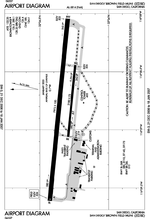Otay Mesa Port of Entry

The Otay Mesa Port of Entry (Spanish: Puerto de Entrada Mesa de Otay) is one of three ports of entry (POE) in the San Diego–Tijuana metropolitan region, in the U.S. state of California, connecting Otay Mesa in the City of San Diego with the Otay Centenario borough of Tijuana. The facility was opened in 1983, and was constructed primarily to divert growing commercial truck traffic from the busy San Ysidro Port of Entry, located 5.2 miles (8.4 km) west. Since then, significant passenger vehicle and pedestrian traffic has grown as development in the area around the crossing has grown. Commercial importations through Otay Mesa accounts for billions of dollars' worth of freight.The Otay Mesa Port of Entry is accessed by California State Route 905 on the northern side. Since commercial traffic cannot use the San Ysidro Port of Entry, for commercial traffic Otay Mesa is the southern terminus of the Interstate 5 corridor. The port of entry is the third-busiest commercial port of entry on the Mexico–United States border. To reduce wait times a facility built by the Mexican federal government, staffed by United States Customs and Border Protection officers and Mexican customs officers, will be opened on the Mexican side of the border. It will be used to screen produce, which are considered low-risk commodities. A similar facility will be located at the Laredo International Airport, where Mexican customs officers will pre-inspect air shipments into Mexico.
Excerpt from the Wikipedia article Otay Mesa Port of Entry (License: CC BY-SA 3.0, Authors, Images).Otay Mesa Port of Entry
Global Entry SENTRI Lane, San Diego Otay Mesa
Geographical coordinates (GPS) Address Nearby Places Show on map
Geographical coordinates (GPS)
| Latitude | Longitude |
|---|---|
| N 32.550602 ° | E -116.938187 ° |
Address
Global Entry SENTRI Lane
Global Entry SENTRI Lane
92179 San Diego, Otay Mesa
California, United States
Open on Google Maps



